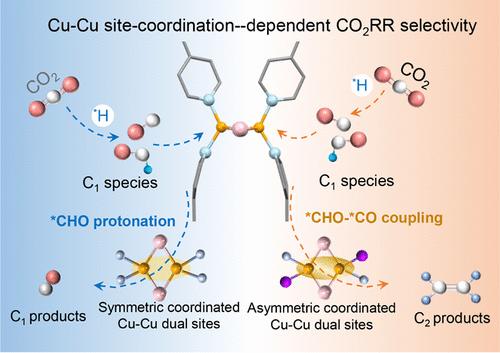通过P和N散射的不对称配位Cu-Cu双位点的扭曲电子定位调节*CO - *CHO二聚化促进CO2电还原
IF 13.1
1区 化学
Q1 CHEMISTRY, PHYSICAL
引用次数: 0
摘要
分子催化剂由于其灵活的配位结构在电催化CO2还原(CO2RR)方面具有高度可调性,以产生增值化学品。然而,它们的实际应用受到限制,因为相邻Cu位点的对称电子分布导致吸附的*C1之间存在很强的排斥力,从而降低了催化效率。本文提出了通过P和N散射保持不对称配位Cu - Cu双位点(Cu2-AC)的概念,通过Cu位点的电子弥散扭曲来调节中间体的吸附构型。得到的Cu2-AC双位点具有较高的C2+(包括C2H2、C2H5OH、CH3COOH和n-PrOH)法拉第效率(~ 75.4%),是Cu2-SC(44.4%)的1.7倍,在连续操作中具有出色的稳健性。原位表征和理论计算表明,本质局部对称破断Cu2-AC双位点可以实现Cu-Cu位点周围电子云的不对称分布,从而促进活性氢的生成,优先有利于CO2的活化,从而加速不对称的*CO - *CHO二聚化。基于这一发现的配位调控策略为开发下一代双原子位点催化剂提供了一种方法,该催化剂可产生用于二氧化碳还原的多碳产物。本文章由计算机程序翻译,如有差异,请以英文原文为准。

Tuning *CO–*CHO Dimerization via Twisted Electron Localization of Asymmetrically Coordinated Cu–Cu Dual Sites by P and N Scatterings Boosts CO2 Electroreduction
Molecular catalysts are highly tunable due to their flexible coordination configurations in terms of electrocatalytic CO2 reduction (CO2RR) to generate value-added chemicals. However, their practical applications are limited by the fact that the symmetrical electron distribution at adjacent Cu sites leads to a strong repulsive force between adsorbed *C1, which reduces catalytic efficiency. Herein, the concept of holding asymmetrically coordinated Cu–Cu dual sites by P and N scattering (Cu2-AC) is proposed to regulate the adsorption configurations of intermediates through the twisting of the electron dispersion of Cu sites. The obtained Cu2-AC dual sites exhibit a higher C2+ (involving C2H2, C2H5OH, CH3COOH, and n-PrOH) Faradaic efficiency of ∼75.4%, which is 1.7 times that of Cu2-SC (44.4%), with extraordinary robustness during continuous operation. In situ characterizations and theoretical calculations document that the intrinsically local symmetry-breaking Cu2-AC dual sites can realize the unsymmetrical distribution of the electron cloud around Cu–Cu sites, consequently promoting the generation of active hydrogen species and preferentially favoring the activation of CO2 species, thereby accelerating the asymmetric *CO–*CHO dimerization. The coordination regulation strategy based on this discovery offers an approach to developing next-generation dual-atom site catalysts that generate multicarbon products for CO2 reduction.
求助全文
通过发布文献求助,成功后即可免费获取论文全文。
去求助
来源期刊

ACS Catalysis
CHEMISTRY, PHYSICAL-
CiteScore
20.80
自引率
6.20%
发文量
1253
审稿时长
1.5 months
期刊介绍:
ACS Catalysis is an esteemed journal that publishes original research in the fields of heterogeneous catalysis, molecular catalysis, and biocatalysis. It offers broad coverage across diverse areas such as life sciences, organometallics and synthesis, photochemistry and electrochemistry, drug discovery and synthesis, materials science, environmental protection, polymer discovery and synthesis, and energy and fuels.
The scope of the journal is to showcase innovative work in various aspects of catalysis. This includes new reactions and novel synthetic approaches utilizing known catalysts, the discovery or modification of new catalysts, elucidation of catalytic mechanisms through cutting-edge investigations, practical enhancements of existing processes, as well as conceptual advances in the field. Contributions to ACS Catalysis can encompass both experimental and theoretical research focused on catalytic molecules, macromolecules, and materials that exhibit catalytic turnover.
 求助内容:
求助内容: 应助结果提醒方式:
应助结果提醒方式:


